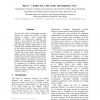Free Online Productivity Tools
i2Speak
i2Symbol
i2OCR
iTex2Img
iWeb2Print
iWeb2Shot
i2Type
iPdf2Split
iPdf2Merge
i2Bopomofo
i2Arabic
i2Style
i2Image
i2PDF
iLatex2Rtf
Sci2ools
ACL
2011
2011
Joint Bilingual Sentiment Classification with Unlabeled Parallel Corpora
Most previous work on multilingual sentiment analysis has focused on methods to adapt sentiment resources from resource-rich languages to resource-poor languages. We present a novel approach for joint bilingual sentiment classification at the sentence level that augments available labeled data in each language with unlabeled parallel data. We rely on the intuition that the sentiment labels for parallel sentences should be similar and present a model that jointly learns improved monolingual sentiment classifiers for each language. Experiments on multiple data sets show that the proposed approach (1) outperforms the monolingual baselines, significantly improving the accuracy for both languages by 3.44%-8.12%; (2) outperforms two standard approaches for leveraging unlabeled data; and (3) produces (albeit smaller) performance gains when employing pseudo-parallel data from machine translation engines.
| Added | 23 Aug 2011 |
| Updated | 23 Aug 2011 |
| Type | Journal |
| Year | 2011 |
| Where | ACL |
| Authors | Bin Lu, Chenhao Tan, Claire Cardie, Benjamin K. Tsou |
Comments (0)

